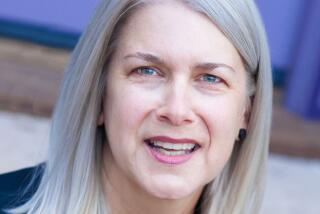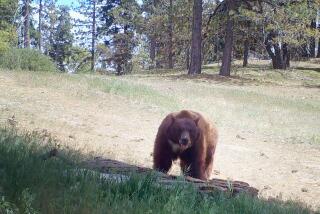A dark Arctic tale set after the ice melts
It’s hard to imagine a world in which polar bears don’t exist in the wild. Alun Anderson, former editor-in-chief of New Scientist magazine, asserts that it most likely will occur in our lifetime.
In his book, “After the Ice: Life, Death, and Geopolitics in the New Arctic” (HarperCollins, 2009), Anderson takes a close look at the complicated past, present and future of the Arctic region, the area of Earth that he says is certain to feel the effects of global warming first and most powerfully.
Anderson traveled extensively in the Arctic to tell the story of a place that few are familiar with.
His greatest frustration was that no one he spoke with was taking the long or multifaceted view when discussing the region -- considering the environmental along with the political; the business with the science; the way of life of those who actually live in the Arctic with movements to protect endangered animals.
Anderson talked about the book, and gave his predictions for the region’s future:
You begin your book describing the first polar bear you ever saw. Can you describe the moment and how it led to this book?
I’d gone on a trip to the Canadian Arctic by chance. I knew nothing about the Arctic. We set off on our first day, and I’d flown in from England and was quite jet-lagged, so I stayed up all night. I went up on deck. I saw this small dot in the distance, which as we got closer, it was a polar bear. It ignored the boat completely. It was the bear’s world. I was talking to a biologist up on deck, and he told me: “This bear will not make it through the year. It is too thin. And there is no ice for it to swim out to for the bear to hunt from.”
I was completely gutted. I wanted to know more about the bear and the ice.
In the summer of 2007, a large area of ice in the Arctic (625,000 square miles, four times the size of California) melted away at a speed no one has seen before. You call it “the great crash of 2007.” Was this a first signal that global warming was becoming more potent?
Yes, that’s right. Global warming had been making the ice thinner for a long time. But that wasn’t apparent. From a satellite view, you just see ice. You don’t know if it is thick or thin. That was a very sunny summer, and suddenly we knew that this ice was a complete mess. The melting forced scientists to think again about what they knew. They couldn’t see before that the area was becoming more vulnerable. Their previous data revealed we wouldn’t get [to the point of a massive ice melt] until 2056. We reached it 50 years early.
You write about how the politics of the “south” can cause trouble for Arctic people. For instance, you describe villages in Greenland becoming impoverished because of environmentalists’ campaigns to ban the import of seal products to other nations. Can you explain?
Everyone has seen the pictures of baby white seals being clubbed to death. Most people agree that this should not be allowed.
What this led to, though, were bans on seal products being imported, into Europe, particularly.
Throughout the Inuit Arctic, they don’t [club baby seals]. They hunt adult seals. All of a sudden, their means of income was completely wiped out. They say they’ve been doing it for over 100 years. They say: “Why can’t you accept our way of life?” They got caught up in something that has nothing to do with them.
What was your greatest discovery along this journey?
At a personal level, it was visiting a really northern Inuit community and seeing how a hunting community lives. There on the beach were dead seals and the head of a narwhal. That is how humans lived long ago. It was striking to see a hunter-gatherer society. I had to adjust my values -- there are still hunting communities in this world.
What will happen “down South” if the Arctic completely melts? You call it “the Arctic’s Revenge.”
A big shock to me is that this melt is unstoppable now. In a relatively short time, the Arctic will be ice-free. Going from bright, white ice to black water should be a signal to the world that something is coming. As the ice is melting, it is changing weather patterns in the Northern Hemisphere.
As the ice melts, there will be a rise in sea level. Perhaps 3 feet. That may not sound like a lot, but if you look at a 1-foot rise and what happens -- it takes out chunks of cities.
As the ocean warms, it lets off greenhouse gases, which will warm the Earth further. As the permafrost thaws out, microorganisms get active and digest carbon. It will be a slow change, but it will give us centuries of further warming we can’t stop.
When will the Arctic melt completely?
The year when the sea ice in the summer will be gone -- the date predictions range from 2013 to 2050. If it is within 10 years, I wouldn’t be surprised.
You write that the issue of who owns the Arctic region is complicated.
There is still a lot of area [that] a lot of people are claiming -- Russia, the U.S., Greenland, Norway and Canada. They all claim to extend their territory further out into the Arctic waters. The first 200 miles out from the land, no one disputes that. But every nation is keen on claiming more.
They are claiming more and more sea bottom because the United Nations Law of the Sea gives you only 10 years to make a claim. If you don’t make a claim, it is lost forever. They are claiming the area in case there is something of value there in the future.
What about oil?
On the Russian side of the Arctic, where there are tremendous amounts of oil and gas, Russia is pushing ahead, out into the Arctic Sea -- they’ve got nothing stopping them, and they need the wealth. . . . In the Chukchi Sea, the U.S. has a large amount of oil. The big oil companies (particularly Shell) had plans to drill exploratory wells miles off the north coast of Alaska. . . . The environmental groups of Alaska do not want the off-shore oil activities because they are afraid more species will be endangered. The indigenous people are opposed to off-shore oil [drilling] because they are afraid they won’t be able to catch whales.
If the ice melts completely, will polar bears disappear completely?
Yes. That’s right.
Walruses?
They probably won’t disappear completely, but they’ll be really decimated. The way they live -- the mother has the pups on the ice. The ice moves north as it melts. The mother and her babies usually float along, but the ice is melting so fast, mothers and pups are being carried into regions where they can’t feed.
Whales?
The beluga has the best chance. It is quite a generalist.
The narwhal -- it is a specialist at finding food under the ice. No one else gets into that area because the narwhal has cornered the market. As the ice melts, killer whales will get into the Arctic and will hunt and kill the narwhal.
Plankton?
There will be more open water exposed to light for longer, so more green stuff in the water.
What are your predictions for the Arctic’s future? What will it look like in 2050?
By 2050, the Arctic will be free of ice in the summer. A lot of the permafrost will have melted. A lot of houses and villages will have been sunk.
We don’t yet know what a future Arctic will look like. Will it become a sort of wasteland? Or will it be heavily exploited by the oil and gas industries? An industrially developed Arctic for the benefit of the people of the south -- the land has been raped, leaving the people of the Arctic impoverished: That would be a nightmare.
Note: After this Q & A was published, a number of readers wrote or called to question the impact of melting Arctic ice on sea levels. We followed up with Anderson. Here is his reply:
There are two kinds of ice. Sea ice melts away, and as the white ice turns to dark water it will soak up more heat, melt more ice and the changing heat balance between the poles and further south will (in fact, is already) mess with the weather down south. Melting sea ice does not change sea level because it is floating on the sea.
The ice on land in the Arctic, most of it on Greenland, is also melting and flowing faster into the sea as the movement of glaciers speeds up (between 1992 and 2003, the speed of the biggest of these glaciers, over two miles wide, more than doubled). That water does add to sea level.
If it all melted away, sea levels would rise by about 23 feet. That is from Greenland alone and does not consider the Antarctic or other great ice areas that are also melting. This won’t happen tomorrow -- it will take many hundreds of years.
A reasonable total estimate for this century is that sea levels will rise two to three feet. That will be a mix of Greenland melting, Antarctic melting, other sources and the natural expansion of the sea as it grows warmer. Two to three feet may not sound a lot until you think just how long coastlines are and how many towns and cities are by the sea (to say nothing of low-lying nations like Holland, or Pacific Islands or the Bangladesh delta). It costs billions to raise coastal defenses a few feet, and you’ll be repeating the exercise very soon. That’s just the first two or three of 23 feet of sea level rise from Greenland and 60 feet from Antarctica. It may be more sensible -- and a lot cheaper -- to cut global warming now than fight its effects for centuries.
What did you think of Anderson’s Q & A? Weigh in here.
More to Read
Start your day right
Sign up for Essential California for news, features and recommendations from the L.A. Times and beyond in your inbox six days a week.
You may occasionally receive promotional content from the Los Angeles Times.






